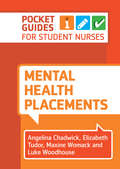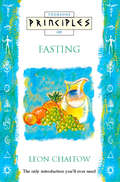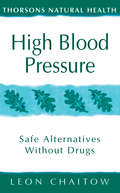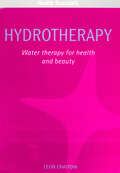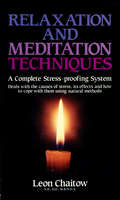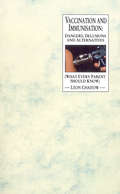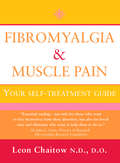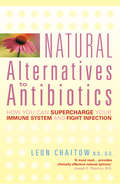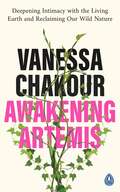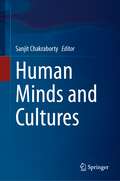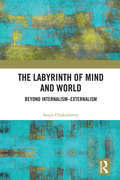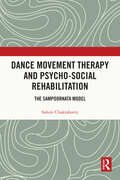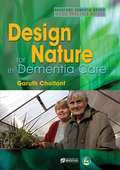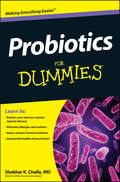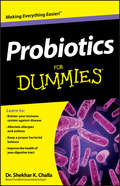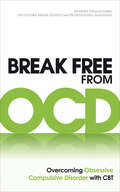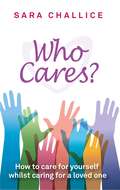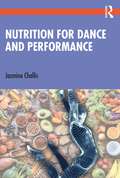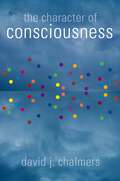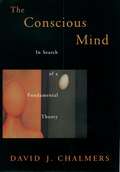- Table View
- List View
Mental Health Placements: A Pocket Guide (Pocket Guides)
by Angelina Chadwick Elizabeth Tudor Maxine Womack and Luke WoodhouseA handy pocket guide to help mental health student nurses prepare for their practice placements. Mental health nursing placements can be daunting – you’ll be working in a variety of settings and supporting individuals with a range of mental health problems. There are new colleagues to work with, and newly learned nursing theory to put into practice. This pocket guide is designed to make your placements much more enjoyable and less stressful.
Fasting: The Only Introduction You'll Ever Need (Principles of)
by Leon ChaitowBy allowing the body to rest and heal itself naturally, fasting not only restores energy and well-being but also treats conditions such as rheumatoid arthritis, psoriasis and eczema.
High Blood Pressure: Safe Alternatives Without Drugs (Thorsons Natural Health)
by Leon ChaitowThis series of self-help guides contain natural, safe and effective treatments for a wide range of health problems.
Hydrotherapy
by Leon ChaitowWater is a powerful ally in our search for health and beauty. Used therapeutically, it can help us to retain or regain our health, beauty, well-being and vitality.
Relaxation and Meditation Techniques: A Complete Stress-proofing System
by Leon ChaitowLeon Chaitow examines the main causes of stress and its effects on health, and provides check-lists for assessing your own levels of stress.
Vaccination And Immunisation: Dangers, Delusions and Alternatives (What Every Parent Should Know)
by Leon ChaitowVaccinations and immunisation procedures as safe and effective as we are told. They offer some protection, but far less that is generally supposed, and at a cost in terms of short and long term hazards. In this book, learn everything a parent should know about the dangers of vaccination and immunisation, both short and long term, and discover the safe alternatives.
Fibromyalgia and Muscle Pain: Your Self-treatment Guide (text Only) (Thorsons Health Ser.)
by Leon Chaitow, N.D., D.O.A practical guide to this increasingly common chronic fatigue disorder.
Natural Alternatives to Antibiotics: How You Can Supercharge Your Immune System And Fight Infection
by Leon Chaitow, N.D., D.O.We now know that antibiotics are not the simple solution we once thought. But how can we stay well without them? This book shows how to keep your immune system in peak condition – and stay healthy without antibiotics.
Awakening Artemis: Deepening Intimacy with the Living Earth and Reclaiming Our Wild Nature
by Vanessa ChakourWe all come from different cultures and practice different spiritual traditions, but we have one thing in common: we are all of the earth. Vanessa Chakour, founder of the rewilding programme Sacred Warrior, takes us on a journey to deepen our relationship with ourselves and the environment. Awakening Artemis is her love letter to the earth.Sharing her personal journey of rewilding, her stories act as tools, both practical and inspirational, to encourage growth, healing and reconnection to the regenerative power of the natural world. Vanessa will help you embrace the strength and beauty in the wild, the weeds, and the unsavoury parts of yourself in order to grow and heal. By allowing yourself and the earth to flourish and awakening your inner Artemis, Chakour promises that you will find joy, peace, compassion for yourself, others, and the planet.
Human Minds and Cultures
by Sanjit ChakrabortyThis book puts forward a harmonious analysis of similarities and differences between two concepts—human minds and cultures—and strives for a multicultural spectrum of philosophical explorations that could assist them in pondering the striking pursuit of envisaging human minds and cultures as an essential appraisal of philosophy and the social sciences. The book hinges on a theoretical understanding of the indispensable liaison between the dichotomy of minds and objectivity residing in semantic-ontological conjectures. The ethnographic sense of cultures confines the scope of cultural scientism, an evolutionary paradigm on the functionalist turn, where one could enthral the cultural phenomenon from the contentment of the conflict of scientific quandaries. Hence, cultural relativism concedes that cultures have some descriptive contents, like customs, beliefs, moral codes, other minds, etc., that are followed by an individual or a group of people. However, the notion of societalsemiotics embarks on the ‘semiotic conception of culture’ that deploys modernity and values centred on ethical conjectures. Human Minds and Cultures conspicuously attune the cultural edifice of moral minds and cope with the enduring prospects of ethics, genders, laws, and socio-political affairs. Essential reading for anyone with a sparkling interest in human minds and cultures.
The Labyrinth of Mind and World: Beyond Internalism–Externalism
by Sanjit ChakrabortyThis book carries forward the discourse on the mind’s engagement with the world. It reviews the semantic and metaphysical debates around internalism and externalism, the location of content and the indeterminacy of meaning in language. The volume analyzes the writings of Jackson, Chomsky, Putnam, Quine, Bilgrami and others, to reconcile opposing theories of language and the mind. It ventures into Cartesian ontology and Fregean semantics to understand how mental content becomes world-oriented in our linguistic communication. Further, the author explores the liaison between the mind and the world from the phenomenological perspective, particularly, Husserl’s linguistic turn and Heidegger’s intersubjective entreaty for Dasein. The book conceives of thought as a biological and socio-linguistic product which engages with the mind-world question through the conceptual and causal apparatuses of language. A major intervention in the field of philosophy of language, this book will be useful for scholars and researchers interested in philosophy, phenomenology, epistemology and metaphysics.
The Labyrinth of Mind and World: Beyond Internalism–Externalism
by Sanjit ChakrabortyThis book carries forward the discourse on the mind’s engagement with the world. It reviews the semantic and metaphysical debates around internalism and externalism, the location of content and the indeterminacy of meaning in language. The volume analyzes the writings of Jackson, Chomsky, Putnam, Quine, Bilgrami and others, to reconcile opposing theories of language and the mind. It ventures into Cartesian ontology and Fregean semantics to understand how mental content becomes world-oriented in our linguistic communication. Further, the author explores the liaison between the mind and the world from the phenomenological perspective, particularly, Husserl’s linguistic turn and Heidegger’s intersubjective entreaty for Dasein. The book conceives of thought as a biological and socio-linguistic product which engages with the mind-world question through the conceptual and causal apparatuses of language. A major intervention in the field of philosophy of language, this book will be useful for scholars and researchers interested in philosophy, phenomenology, epistemology and metaphysics.
Dance Movement Therapy and Psycho-social Rehabilitation: The Sampoornata Model
by Sohini ChakrabortyThis book looks at the psychotherapeutic effects of Dance Movement Therapy (DMT) with a focus on the experiences of survivors of gender-based violence and their social development, psycho-social rehabilitation, and reintegration within society. The author, a sociologist and dancer, uses a model she calls Sampoornata— or Fulfilment, to merge sociology and dance in order to help survivors of sexual violence overcome their trauma. Sampoornata was developed to help survivors of gender-based violence and trafficking, by focusing on their specific needs, and helping them to express themselves and overcome emotional and psychological pain. Through interviews with and detailed narratives of survivors, the book takes the readers through the development of the model, its implementation, practice, and impact on their lives. Situated within the social, cultural, as well as geographical context of India, the book is an important resource for rethinking the creative approaches, theories, and practice of DMT worldwide. This book will be of interest to researchers and students of psychology, psychotherapy, dance and movement studies, and to those who work with dance and movement therapy. It will also be useful for professionals working in the areas of gender violence, trafficking, trauma, psycho-social rehabilitation, and well-being.
Dance Movement Therapy and Psycho-social Rehabilitation: The Sampoornata Model
by Sohini ChakrabortyThis book looks at the psychotherapeutic effects of Dance Movement Therapy (DMT) with a focus on the experiences of survivors of gender-based violence and their social development, psycho-social rehabilitation, and reintegration within society. The author, a sociologist and dancer, uses a model she calls Sampoornata— or Fulfilment, to merge sociology and dance in order to help survivors of sexual violence overcome their trauma. Sampoornata was developed to help survivors of gender-based violence and trafficking, by focusing on their specific needs, and helping them to express themselves and overcome emotional and psychological pain. Through interviews with and detailed narratives of survivors, the book takes the readers through the development of the model, its implementation, practice, and impact on their lives. Situated within the social, cultural, as well as geographical context of India, the book is an important resource for rethinking the creative approaches, theories, and practice of DMT worldwide. This book will be of interest to researchers and students of psychology, psychotherapy, dance and movement studies, and to those who work with dance and movement therapy. It will also be useful for professionals working in the areas of gender violence, trafficking, trauma, psycho-social rehabilitation, and well-being.
Design for Nature in Dementia Care
by Garuth ChalfontMaintaining a connection to nature is increasingly recognised as an important component of caring for a person with dementia. Design for Nature in Dementia Care provides comprehensive examples of ways to connect to nature through indoor and outdoor activities. The author describes a wide range of activities that offer a connection to nature, such as caring for house plants and pets, gardening and cooking, practising handicrafts and domestic chores. He suggests practical ways to incorporate nature into indoor and outdoor environments and also into the design of buildings and landscapes. These suggestions are drawn from interdisciplinary research in environmental psychology, neurology, architecture, nursing and dementia care practice. This book is a practical resource for care providers and design professionals who want to use nature to improve the lives of people with dementia.
Design for Nature in Dementia Care (PDF)
by Garuth ChalfontMaintaining a connection to nature is increasingly recognised as an important component of caring for a person with dementia. Design for Nature in Dementia Care provides comprehensive examples of ways to connect to nature through indoor and outdoor activities. The author describes a wide range of activities that offer a connection to nature, such as caring for house plants and pets, gardening and cooking, practising handicrafts and domestic chores. He suggests practical ways to incorporate nature into indoor and outdoor environments and also into the design of buildings and landscapes. These suggestions are drawn from interdisciplinary research in environmental psychology, neurology, architecture, nursing and dementia care practice. This book is a practical resource for care providers and design professionals who want to use nature to improve the lives of people with dementia.
Probiotics For Dummies
by Shekhar ChallaDiscover the pros of probiotics Probiotics are beneficial, live microorganisms (in most cases, bacteria) that are similar to those found naturally in the human intestine. Also known as "friendly" or "good" bacteria, probiotics are the cornerstone of any successful health program because they restore a healthy balance between friendly and bad bacteria in the intestinal tract, a balance that is critical for the health of the entire body. Probiotics are associated with treating everything from IBS to certain forms of cancer, allergies, eczema, and even the effects of aging. Probiotics For Dummies reveals how taking the right probiotics—in the form of food and supplements— as part of a total health program benefits one's overall health, as well as improving specific conditions. This hands-on, essential guide features 20 probiotic recipes and gives you a step-by-step plan for infusing probiotics into your diet to improve the health of the GI tract, alleviate allergies and asthma, restore reproductive and urinary tracts, bolster the immune system against disease, enhance weight loss, and more. Advice on how to ingest the right probiotics 20 probiotic recipes from breakfast to dessert Information on naturally occurring probiotic compounds as well as the effectiveness of supplements Probiotics For Dummies gives you everything you need to make informed decisions about adding probiotics to your daily diet.
Probiotics For Dummies
by Shekhar ChallaDiscover the pros of probiotics Probiotics are beneficial, live microorganisms (in most cases, bacteria) that are similar to those found naturally in the human intestine. Also known as "friendly" or "good" bacteria, probiotics are the cornerstone of any successful health program because they restore a healthy balance between friendly and bad bacteria in the intestinal tract, a balance that is critical for the health of the entire body. Probiotics are associated with treating everything from IBS to certain forms of cancer, allergies, eczema, and even the effects of aging. Probiotics For Dummies reveals how taking the right probiotics—in the form of food and supplements— as part of a total health program benefits one's overall health, as well as improving specific conditions. This hands-on, essential guide features 20 probiotic recipes and gives you a step-by-step plan for infusing probiotics into your diet to improve the health of the GI tract, alleviate allergies and asthma, restore reproductive and urinary tracts, bolster the immune system against disease, enhance weight loss, and more. Advice on how to ingest the right probiotics 20 probiotic recipes from breakfast to dessert Information on naturally occurring probiotic compounds as well as the effectiveness of supplements Probiotics For Dummies gives you everything you need to make informed decisions about adding probiotics to your daily diet.
Break Free from OCD: Overcoming Obsessive Compulsive Disorder with CBT
by Dr Fiona Challacombe Dr Victoria Bream Oldfield Paul M SalkovskisAre you plagued by obsessive thoughts, rituals or routines? Would you like to regain control over your behaviour and cast your fears aside?Whether you are compelled to wash your hands more and more thoroughly or feel the need to keep checking that you've turned off appliances, obsessive worries can be a drain on daily life. However, you don't need to suffer any more. This practical guide, written by three leading cognitive behavioural therapy experts, enables you to make sense of your symptoms, and gives a simple plan to help you conquer OCD.Includes: detailed information on the many different manifestations of OCD; the differences between normal and obsessive worries; clear information on treating your individual problem; real-life case studies and examples; and advice and support for friends and family of OCD sufferers.Whether your condition is mild or severe, this definitive resource will help you reclaim your life and keep OCD away for good.
Who Cares?: How to care for yourself whilst caring for a loved one
by Sara ChalliceStatistics show that most carers eventually fall mentally or physically unwell, brought on by the pressures of caring, often alone. Some die before the cared-for and most only learn to take care of themselves the hard way and too late. Who Cares? aims to stop this needless suffering, giving practical know-how, and guiding carers to make the right choices so that they safeguard their own health and wellbeing. In making the smallest of changes and rethinking their personal perspective on their role and its value, carers can radically transform their lives and those they care for. In sharing her own story, and the experiences and case studies of other carers, Sara shows the crucial steps to wellbeing, to help carers enjoy life again. Her book is an inspiring and empathetic guide to staying healthy and happy as a carer.
Nutrition for Dance and Performance
by Jasmine ChallisNutrition for Dance and Performance is the first complete textbook written by an experienced dietitian specialising in the field of dance nutrition. It seeks to provide both dancers-in-training and instructors with practical advice on dance nutrition for health and performance. It is also highly relevant for dance professionals. With an in-depth and extensive coverage on all nutrition topics relevant to dancers, this book covers nutrition for the scenarios dancers face, including day-to-day training and rehearsals, peak performance, injuries, immunonutrition, nutrition and stress management. Information is included on topics applicable to individual dancers including advice for dancers with Type 1 diabetes and clinical conditions relating to gut health. The book guides the reader through the macronutrients making up the diet, their chemical structure and their role in health and optimal performance. Readers are shown how to estimate energy and nutrient needs based on their schedule, type of dance undertaken and personal goals before considering the practical aspects of dance nutrition; from nutrition planning to dietary supplements, strategies for assessing the need to alter body composition and guidance on undertaking health-focused changes. Nutrition for Dance and Performance combines and condenses the author’s knowledge and many years of experience working in the dance industry to translate nutrition science into a practical guide. Bringing together the latest research in dance science and nutrition, this book aims to be a trusted reference and practical textbook for students of Dance, Dance Nutrition, Dance Performance, Sport Nutrition and Sport Science more generally as well as for those training in the dance industry, dance teachers and professionals. Jasmine Challis is a freelance Registered Nutritionist (UK Association for Nutrition) and Dietitian registered with the Health Care Professions Council, and is on the UK Sport and Exercise Nutrition Register (SENR) focusing on dance. She completed an MRes in Sport and Exercise Science in 2018. She is on the Dance Medicine and Science Expert Panel for One Dance UK and is on the board of The Bridge Dance Project. She has worked across the dance field for over 30 years giving talks, running workshops and providing 1:1 sessions for dancers and dance students.
Nutrition for Dance and Performance
by Jasmine ChallisNutrition for Dance and Performance is the first complete textbook written by an experienced dietitian specialising in the field of dance nutrition. It seeks to provide both dancers-in-training and instructors with practical advice on dance nutrition for health and performance. It is also highly relevant for dance professionals. With an in-depth and extensive coverage on all nutrition topics relevant to dancers, this book covers nutrition for the scenarios dancers face, including day-to-day training and rehearsals, peak performance, injuries, immunonutrition, nutrition and stress management. Information is included on topics applicable to individual dancers including advice for dancers with Type 1 diabetes and clinical conditions relating to gut health. The book guides the reader through the macronutrients making up the diet, their chemical structure and their role in health and optimal performance. Readers are shown how to estimate energy and nutrient needs based on their schedule, type of dance undertaken and personal goals before considering the practical aspects of dance nutrition; from nutrition planning to dietary supplements, strategies for assessing the need to alter body composition and guidance on undertaking health-focused changes. Nutrition for Dance and Performance combines and condenses the author’s knowledge and many years of experience working in the dance industry to translate nutrition science into a practical guide. Bringing together the latest research in dance science and nutrition, this book aims to be a trusted reference and practical textbook for students of Dance, Dance Nutrition, Dance Performance, Sport Nutrition and Sport Science more generally as well as for those training in the dance industry, dance teachers and professionals. Jasmine Challis is a freelance Registered Nutritionist (UK Association for Nutrition) and Dietitian registered with the Health Care Professions Council, and is on the UK Sport and Exercise Nutrition Register (SENR) focusing on dance. She completed an MRes in Sport and Exercise Science in 2018. She is on the Dance Medicine and Science Expert Panel for One Dance UK and is on the board of The Bridge Dance Project. She has worked across the dance field for over 30 years giving talks, running workshops and providing 1:1 sessions for dancers and dance students.
The Character of Consciousness (Philosophy of Mind)
by David J. ChalmersIn this book David Chalmers follows up and extends his thoughts and arguments on the nature of consciousness that he first set forth in his groundbreaking 1996 book, The Conscious Mind.
The Character of Consciousness (Philosophy of Mind)
by David J. ChalmersIn this book David Chalmers follows up and extends his thoughts and arguments on the nature of consciousness that he first set forth in his groundbreaking 1996 book, The Conscious Mind.
The Conscious Mind: In Search of a Fundamental Theory (Philosophy of Mind)
by David J. ChalmersWhat is consciousness? How do physical processes in the brain give rise to the self-aware mind and to feelings as profoundly varied as love or hate, aesthetic pleasure or spiritual yearning? These questions today are among the most hotly debated issues among scientists and philosophers, and we have seen in recent years superb volumes by such eminent figures as Francis Crick, Daniel C. Dennett, Gerald Edelman, and Roger Penrose, all firing volleys in what has come to be called the consciousness wars. Now, in The Conscious Mind, philosopher David J. Chalmers offers a cogent analysis of this heated debate as he unveils a major new theory of consciousness, one that rejects the prevailing reductionist trend of science, while offering provocative insights into the relationship between mind and brain. Writing in a rigorous, thought-provoking style, the author takes us on a far-reaching tour through the philosophical ramifications of consciousness. Chalmers convincingly reveals how contemporary cognitive science and neurobiology have failed to explain how and why mental events emerge from physiological occurrences in the brain. He proposes instead that conscious experience must be understood in an entirely new light--as an irreducible entity (similar to such physical properties as time, mass, and space) that exists at a fundamental level and cannot be understood as the sum of its parts. And after suggesting some intriguing possibilities about the structure and laws of conscious experience, he details how his unique reinterpretation of the mind could be the focus of a new science. Throughout the book, Chalmers provides fascinating thought experiments that trenchantly illustrate his ideas. For example, in exploring the notion that consciousness could be experienced by machines as well as humans, Chalmers asks us to imagine a thinking brain in which neurons are slowly replaced by silicon chips that precisely duplicate their functions--as the neurons are replaced, will consciousness gradually fade away? The book also features thoughtful discussions of how the author's theories might be practically applied to subjects as diverse as artificial intelligence and the interpretation of quantum mechanics. All of us have pondered the nature and meaning of consciousness. Engaging and penetrating, The Conscious Mind adds a fresh new perspective to the subject that is sure to spark debate about our understanding of the mind for years to come.
